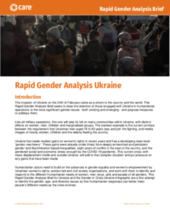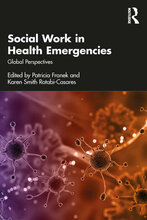Demographic Data
|
Sources: World Bank, UNDP, UNAIDS, DHS 2013 |
Displaying 1941 - 1950 of 14391
This Rapid Gender Analysis Brief seeks to draw the attention of those engaged with Ukraine in humanitarian operations to the most significant gender issues both existing and emerging and propose measures to address them.
This is the first comprehensive book that provides accessible, international knowledge for practitioners, students and academics about social work in health emergencies and spans fields of practice across world regions with particular reference to the COVID-19 pandemic. The book is relevant to a wide range of audiences, including practitioners, educators and students in social work, human services, international development and public health, as well as policy makers and researchers.
Nothing crystallizes the “her body, my baby” conundrum of surrogacy quite like a war. Should a surrogate be tucked away somewhere safe, to protect the child she’s growing for someone else? Or should she be with her own family, or in her hometown, or even out on the streets defending her nation? That is a live question in Ukraine right now.
The overall aims of this research project were to explore the experiences of the children, parents and families involved in alternative care in Thailand. This research project reached a significant number of children (n.160) living in alternative care and their parents and families (n.20).
What has war looked like for the children of Ukraine? For many, it has meant sheltering in basements and subway stations while Russian forces attack cities and street fights rage. For others, it has meant a scramble to escape, leaving homes and fathers, taking trains and buses or walking for miles with their families in hopes of crossing into a safer country.
KYIV, Ukraine—Krystyna Krayevska came to Kyiv from Poland, where she normally lives and works, for her niece Darynka’s sixth birthday in January. A few days later, Darynka was diagnosed with a brain tumor and, after complications following surgery, now lies on life support in Ukraine’s largest children’s hospital, Okhmatdyt.
The Government of Ukraine released this updated procedure for border crossing for orphans and children without parental care.
Separating a baby from his or her mother at birth when there are safeguarding concerns is traumatic for birth parents and painful for professionals. This report presents findings from a study that analysed qualitative data from the lived experiences of parents and professionals where the state intervened at birth. The aim was to identify key challenges and to surface good practice examples with a view to developing a draft set of best practice guidelines for piloting with partner research sites in England and Wales.
The Protection Cluster coordinates the protection response and advocates for the improvement of policies and legislation affecting conflict-affected people. It also engages in capacity building and provides guidance on mainstreaming protection into all humanitarian response activities. This is the protection snapshot for Ukraine for the period February 25 - March 1, 2022, compiled by Protection Cluster Ukraine.
At least 7.5 million children are in grave danger of physical harm, severe emotional distress and displacement. Families forced to flee will be in urgent need of assistance with shelter, food and clean water. Whenever children are forced to flee their home, there is a risk that children will become separated from their families.






